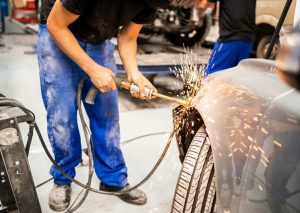Essential Safety Tips for Welding on Truck Frames
Welding on truck frames is a critical task that demands not only technical skill but also a strong focus on safety. Truck frames bear heavy loads and endure constant stress, so welding repairs or customizations must be done with precision and caution. However, welding itself poses various hazards including burns, electric shock, fumes, and fire risks. This comprehensive guide will provide essential safety tips to protect yourself and ensure the quality and durability of your truck frame welding projects.
Understanding the Hazards of Welding on Truck Frames
Welding is a high-heat process that involves electricity, molten metal, and potentially harmful gases. When working on truck frames, the complexity increases due to the size and material thickness involved. Common hazards include:
Burns and Eye Injuries
The intense heat and sparks from welding can cause severe burns. Additionally, ultraviolet (UV) and infrared (IR) radiation emitted during welding can damage your eyes, leading to “welder’s flash” or photokeratitis.

Electric Shock
Welding equipment uses high voltage and current, and improper handling or damaged cables can cause serious electric shocks, which can be fatal.
Exposure to Harmful Fumes and Gases
Welding on truck frames, especially with coated metals or paint residues, can release toxic fumes. Prolonged inhalation may lead to respiratory problems or long-term health issues.
Fire and Explosion Risks
Sparks and molten metal can ignite flammable materials in the workspace, including fuel residues in truck frames or nearby equipment.
Essential Safety Equipment for Truck Frame Welding
Before beginning any welding project on truck frames, it’s vital to equip yourself properly. Here’s what you need:
Personal Protective Equipment (PPE)
Welding Helmet: Use an auto-darkening helmet with a proper shade rating to protect eyes and face from UV and IR radiation.
Protective Clothing: Wear flame-resistant jackets, long sleeves, and pants to protect skin from sparks and heat. Avoid synthetic fabrics that melt.
Welding Gloves: Heavy-duty, heat-resistant gloves protect your hands from burns and electric shock.
Respirator or Welding Fume Mask: Use appropriate respiratory protection to filter harmful fumes, especially in enclosed spaces.
Safety Boots: Steel-toed, non-slip boots protect feet from heavy falling objects and hot metal.
Workspace Safety Gear
Fire Extinguisher: Keep a Class D fire extinguisher nearby for metal fires, plus a standard ABC extinguisher for general use.
Ventilation: Ensure adequate ventilation or use local exhaust ventilation to remove harmful welding fumes from the workspace.
Welding Curtains or Screens: Protect others nearby from sparks and harmful light by using welding curtains.
Step-by-Step Safety Practices When Welding Truck Frames
1. Inspect the Work Area Thoroughly
Remove any flammable materials such as fuel, oil, rags, or paper from the vicinity. Check the truck frame for any residues or coatings that could release toxic fumes when heated.
2. Prepare the Truck Frame Properly
Clean the welding area of paint, rust, grease, and dirt. Use grinders or wire brushes to expose clean metal, reducing the risk of contaminants causing weld defects or toxic fumes.
3. Ground the Truck Frame Correctly
Ensure a secure ground clamp is attached to the frame close to the weld area. A poor ground can cause electrical hazards or welding defects.
4. Use Proper Welding Techniques
Maintain the correct welding angle, amperage, and speed based on the frame’s material and thickness. Avoid excessive heat buildup which can weaken the frame or cause warping.
5. Keep a Safe Distance from Flammable Components
Be aware of fuel lines, brake lines, and electrical wiring near the welding zone. Shield or remove these components if possible to prevent damage or fire hazards.
6. Work in Well-Ventilated Areas
Whenever possible, weld outdoors or in well-ventilated workshops. Use fans or fume extractors to reduce inhalation of hazardous gases.
7. Take Breaks and Stay Alert
Welding requires concentration. Fatigue can lead to mistakes or accidents. Take regular breaks and avoid welding when tired or under the influence of substances.
Additional Tips for Welding on Heavy Truck Frames
Use the Right Welding Equipment
Choose welding machines and accessories designed for heavy gauge steel. For thick truck frames, stick welding or flux-cored arc welding (FCAW) are often preferred due to their penetration capabilities.
Preheat Thick Sections When Necessary
Preheating thick steel areas can reduce thermal stress and cracking. Use a torch or induction heater and monitor temperatures with a gauge.
Inspect Welds for Quality and Safety
After welding, examine the weld bead for cracks, porosity, or weak spots. Perform non-destructive testing if required, especially for critical frame repairs.
Stay Updated on Safety Regulations
Follow OSHA guidelines and local regulations regarding welding safety and workplace practices. Regularly attend safety training and refreshers.
Conclusion
Welding on truck frames is a demanding task that requires both skill and a strong commitment to safety. By understanding the hazards, equipping yourself with the right protective gear, preparing the workspace correctly, and following safe welding practices, you can minimize risks and produce high-quality, durable welds. Always prioritize safety to protect yourself, your coworkers, and the integrity of the truck frame.
Safe welding ensures that your truck remains reliable and roadworthy for years to come.
